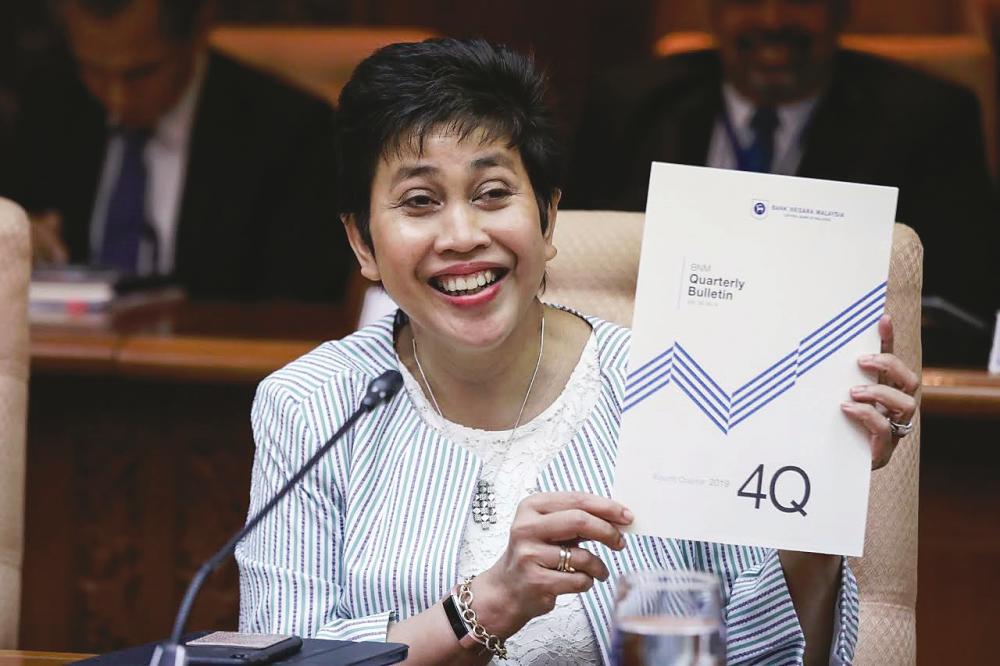KUALA LUMPUR: While supply disruptions in the commodities sector are taking a toll on the economy, which saw Q4 2019 gross domestic product (GDP) growing at the slowest pace in a decade, Bank Negara Malaysia (BNM) governor Datuk Nor Shamsiah Mohd Yunus said there is “ample room” to make adjustments to the monetary policy.
This is given that inflation is still low albeit projected to average higher this year. Last year, headline inflation averaged lower at 0.7%, mainly reflecting the lapse in the impact from the sales and service tax implementation.
Last month, the central bank unexpectedly made a 25 basis-point cut to the Overnight Policy Rate, bringing it to 2.75%. The next Monetary Policy Committee meeting is scheduled on March 3.
In the Q4 economic briefing, Nor Shamsiah said the 3.6% GDP growth rate for Q4 2019 and 4.3% for the full-year of 2019 were the lowest seen since the 2009 global financial crisis.
“The annual GDP growth is at the lower end of our range of 4.3-4.8%. Had we not suffered a supply disruption, our Q4 numbers could be as strong as 4.3%, and for the whole of this year, it could be as high as 4.7%,” she said.
She noted that drought weather had caused a shortage in fertiliser supply which in turn affected palm yields.
During the quarter, the domestic economy continued to be supported by private sector spending which increased 7.4%, compared with 5.4% seen in Q3.
Private investment also registered a higher growth of 4.2%, compared with 0.3% in Q3, driven mainly by improvements in structures investment, in particular, higher capital spending in the civil engineering and residential segments.
Department of Statistics chief statistician Datuk Seri Mohd Uzir Mahidin, who was also present at the briefing, said on the supply side, growth was supported by stronger service sector activities following firm consumer-related spending.
“The manufacturing sector grew 3% on lower electric and electronic (E&E) production growth and a spillover from disruptions in the commodities sector. The construction sector recovered due to strong growth in civil engineering and the turnaround of the residential sub-sector,” he said.
On the external front, exports continued to decline 3.3% in Q4 due to weaker E&E and mineral exports. Imports recorded a smaller contraction of 4% on the turnaround in intermediate imports and a smaller contraction in capital imports.
“The trajectory will be dependent on global oil and commodity price developments and the timing of the lifting of the domestic retail fuel price ceilings. Underlying inflation is expected to remain broadly stable, reflecting the continued expansion in economic activity and the absence of strong demand pressures,” Nor Shamsiah said.
The ringgit gained by 2.3% against the US dollar in Q4, supported mainly by the resumption in non-resident portfolio flows, due to improved investor sentiments following positive developments on global trade negotiations.
For 2019, the ringgit recorded an increase of 1.1% against the dollar, in line with regional currencies.
“The performance of the ringgit in 2020 will continue to be influenced by external developments. While the Phase One trade deal between the US and China contributed to an improved outlook on global trade, investor sentiments are also affected by concerns over the recent coronavirus outbreak,” said Nor Shamsiah.
From the start of this year to Feb 10, the ringgit has weakened 1.3% against the dollar.













